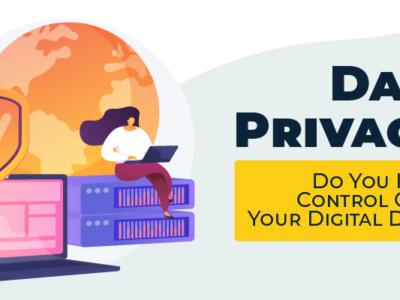After the Facebook–Cambridge Analytica data scandal happened, we all began to take the digital space seriously. Data protection and privacy have become central concepts in today’s business world and marketing is not an exception to this rule.
In this article, we will go over some of the tips and tricks that can help you achieve marketing goals while maintaining safety and transparency.
What is Data Protection?
Data protection is the way in which data is handled by organizations and individuals to ensure that the person’s privacy is not violated. The General Data Protection Regulation, or GDPR, is a set of regulations that govern how personal data must be processed and protected.
The GDPR has been designed to protect the privacy of EU citizens by regulating how businesses process their personal data. It applies to all companies that offer goods or services in the EU, regardless of where they are based.
There is also the California Consumer Privacy Act (CCPA) which gives consumers more control over the personal information collected about them by businesses.
To ensure compliance with privacy regulations, here are some practical marketing tips for achieving results in the data privacy landscape.
1. Implement Data Security Measures While Marketing Your Company
The use of AI technology in marketing is on the rise. This has led to marketers having to update their marketing strategies and utilize the latest marketing tools. The new challenge is how to market your business when enforcing data protection measures.
There are some tips that you can use to market your business while maintaining data protection measures and keeping your customers happy.
Create a Privacy Policy Page: If you have an AI-powered website, it is important that you have a privacy policy page where customers can find out more about what information you collect and how it will be used.
This page should be easily accessible from any page on the website so that customers know where to find it.
2. Why Is Data Ownership Preferable to Third-Party Data Rental?
Google will soon stop supporting third-party cookies and stop providing user data on which 83 percent of marketers still rely to measure campaign performance.
Marketers must use 3P cookie-agnostic marketing measurement tactics to gain insight into their marketing activities if they are to make quick, meaningful decisions based on their data.
The safest move for businesses is to shift their data collection strategy from renting to owning their data. To simplify your data stream, adopt a “less is more” mindset.
Renting third-party data is expensive, and it is frequently outdated, irrelevant, and inaccurate by the time an organization is ready to act on the data.
3. Make the Transition to Gated Offers
Rather than relying on specific individuals to opt in to generic data sharing, provide them with something of value in exchange. This is referred to as providing a gated offer.
Consider the following scenario: suppose you want to learn about customer satisfaction after a website visitor makes an online purchase or schedules an appointment. When the process is complete, send them a survey in which they will be asked for specific information.
In exchange for their time and truthful responses, they will be given a coupon code for a discount on their next purchase. This type of offer places the customer in control of the decision. They don’t have to agree to share the data; instead, they can check a box that allows them to opt out, or they can decline the entire offer.
The key point here is that this offer gives you the option of participating in marketing activities, including creative and often less expensive guerrilla marketing efforts.
4. Be Proactive Regarding Privacy Concerns
The increasing usage of the internet and social media has made it very easy for cybercriminals to steal personal information.
It is important to be proactive about digital privacy concerns, but also know what you are entitled to do in the event that your personal information is compromised.
For example, always send secure emails by following one of the three major protocols for ensuring that your emails are authenticated:
- SPF stands for Sender Policy Framework.
- DKIM stands for DomainKeys Identified Mail
- DMARC stands for Domain-based Message Authentication, Reporting, and Conformance.
SPF is intended for those with little experience with authentication. It is an SPF record that uses DNS records to inform the recipient of which servers and senders are authorized.
DKIM is a public key cryptography technology that adds a digital signature to outgoing emails, allowing recipients to confirm the sender’s authenticity and message integrity.
DMARC is a policy framework designed to prevent phishing attempts by validating emails sent by domains for businesses or other groups. The best part is that your DMARC report gives you a clear idea of how secure your mailing system works.
This protocol ensures email deliverability by preventing messages sent from a company’s website from being flagged as spam.
5. Increase the Frequency of Advertising and Communication
Again, the evolution of digital marketing and privacy will necessitate adaptation to changing circumstances.
Instead of relying on a single message that immediately strikes a chord with your target customer, it is critical to increase ad and communication frequency for a more well-rounded approach.
For example, instead of showing the same ad multiple times, you may need to switch to several ads with different angles.
To increase brand recognition, you may need to increase the number of times you connect with an audience.
6. From Owner to Steward of Customer Data
Marketers must see themselves as stewards of customer data, which isn’t theirs to use unfettered but rather theirs to protect and respect.
Technologically speaking, part of your role as a data steward requires building your mar-tech stack to securely handle and transfer information in ways that reflect customers’ privacy choices and that offer them a high degree of control.
For example, Facebook introduced the Conversions API solution to enable businesses to share their marketing data directly from their servers as an alternative or complement to data shared through web browsers.
Conversions API is designed to honor the privacy choices that people make using Facebook’s data controls while also making it possible for businesses to provide personalized experiences across our apps and services.
The solution can help both improve your performance today and safeguard your performance as browser technologies become less effective in the future.
7. Implement Integrated Brand Metrics
It is critical to fine-tune your integrated brand metrics in order to survive these changes and prepare for what comes next.
What exactly does this mean?
It entails taking a macro-level approach to campaign effectiveness rather than a micro-level approach.
Essentially, you stop focusing on whether individual campaigns were successful or not and begin to evaluate all aspects of your marketing on a consistent basis.
8. Never Share Personal Information on Social Media
People are often not aware of the consequences that come with sharing personal information on social media.
The issue is that people are not always aware of what they are posting, and this can lead to some serious consequences.
For example, people post their credit card numbers on social media because they do not know how to remove them, which can lead to identity theft.
It is important to remember that when you share something on social media, it is never really private.
Anyone who has access to your account can see what you share and take advantage of it. This includes hackers and other malicious users who want your data for their own purposes.
The best way to avoid these problems is by never giving out personal information on social media platforms such as Facebook or Instagram.
This is also why responsible marketers will take care not to solicit personal information in non-secure ways through their social media marketing promotions.
9. Include Transparency and Compliance in Your Methodology
As we saw after the GDPR’s implementation, it is critical to include transparency and compliance in your personal data collection methodology.
While you may not always have control over this, as with Apple and Facebook ads, there are some elements on your website that you do control.
Make sure your privacy policies and other guidelines, for example, are easily accessible on your website.
And provide numerous opportunities for users to opt in or out of specific things, such as email. In fact, if you use templates for your email campaigns, as many marketers do, you can build in these options to ensure they are always included for recipients of your email messages.
The clearer you are on these practices, the less likely you are to face a complaint or monetary fine later on.
10. Continue to Raise Awareness About Privacy Concerns
Privacy concerns are not just a concern for the individual, but also for the company. As a company, it is important to think about what data you are collecting and how you are using that data.
A good way to start is by looking at your company’s privacy policy and updating it if necessary. You should also consider what information you collect from your customers and how you use that information in your marketing materials.
The Bottom Line
Data security is no longer a luxury, and as such, it impacts every marketer and every company. I hope you’ve learned useful tips for achieving your marketing objectives while protecting your customers’ data privacy and security.
Please let me know in the comments if you think I’ve missed something or if you have an idea that can expand on what I’ve included in this article.




